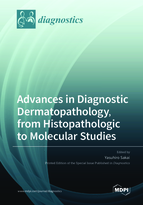Advances in Diagnostic Dermatopathology, from Histopathologic to Molecular Studies
A special issue of Diagnostics (ISSN 2075-4418). This special issue belongs to the section "Pathology and Molecular Diagnostics".
Deadline for manuscript submissions: closed (31 March 2022) | Viewed by 59110
Special Issue Editor
Interests: anatomic pathology (surgical pathology); clinical pathology (laboratory medicine); immunopathology (particularly B-cell immunity); glycobiology (particularly carbohydrate addressin)
Special Issue Information
Dear Colleagues,
Dermatopathology is the most sophisticated area in anatomic pathology; we can easily observe superficial skin lesions using our eyes without the need for an invasive approach and can easily compare gross configurations to microscopic findings. Meanwhile, dermatopathology has recently focused on the study of various cutaneous diseases at molecular biology level. Additionally, dozens and dozens of cutaneous diseases are now being well-researched—melanocytic nevus and malignant melanoma, psoriasis, pemphigus, allergic dermatitis, autoimmune diseases, skin infections, and so on.
Here, we invite investigators such as dermatologists and pathologists to contribute original research articles as well as review articles that reveal novel findings of diagnostic dermatopathology such as diagnosable new morphological (histopathologic) findings, immunohistochemical and immunofluorescent markers, and molecular techniques. We also invite articles that discuss prognostic examinable factors in skin tumors and intractable dermatitis. Relevant case reports will be warmly acknowledged.
Dr. Yasuhiro Sakai
Guest Editor
Manuscript Submission Information
Manuscripts should be submitted online at www.mdpi.com by registering and logging in to this website. Once you are registered, click here to go to the submission form. Manuscripts can be submitted until the deadline. All submissions that pass pre-check are peer-reviewed. Accepted papers will be published continuously in the journal (as soon as accepted) and will be listed together on the special issue website. Research articles, review articles as well as short communications are invited. For planned papers, a title and short abstract (about 100 words) can be sent to the Editorial Office for announcement on this website.
Submitted manuscripts should not have been published previously, nor be under consideration for publication elsewhere (except conference proceedings papers). All manuscripts are thoroughly refereed through a single-blind peer-review process. A guide for authors and other relevant information for submission of manuscripts is available on the Instructions for Authors page. Diagnostics is an international peer-reviewed open access semimonthly journal published by MDPI.
Please visit the Instructions for Authors page before submitting a manuscript. The Article Processing Charge (APC) for publication in this open access journal is 2600 CHF (Swiss Francs). Submitted papers should be well formatted and use good English. Authors may use MDPI's English editing service prior to publication or during author revisions.
Keywords
- Dermatopathology
- Histopathologic findings
- Immunohistochemical markers
- Molecular studies







